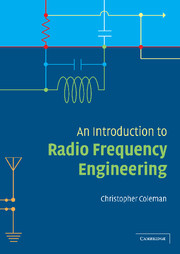Book contents
- Frontmatter
- Contents
- List of figures
- Preface
- Acknowledgements
- 1 Basic concepts
- 2 Frequency selective circuits and matching
- 3 Active devices and amplifiers
- 4 Mixers, modulators and demodulators
- 5 Oscillators and phase locked loops
- 6 Transmission lines and scattering matrices
- 7 Power amplifiers
- 8 Filters
- 9 Electromagnetic waves
- 10 Antennas
- 11 Propagation
- 12 Digital techniques in radio
- Index
2 - Frequency selective circuits and matching
Published online by Cambridge University Press: 05 June 2012
- Frontmatter
- Contents
- List of figures
- Preface
- Acknowledgements
- 1 Basic concepts
- 2 Frequency selective circuits and matching
- 3 Active devices and amplifiers
- 4 Mixers, modulators and demodulators
- 5 Oscillators and phase locked loops
- 6 Transmission lines and scattering matrices
- 7 Power amplifiers
- 8 Filters
- 9 Electromagnetic waves
- 10 Antennas
- 11 Propagation
- 12 Digital techniques in radio
- Index
Summary
Frequency selective circuits are extremely important elements of an RF system. They often consist of a combination of inductors and capacitors that achieves maximum power transfer at a particular frequency or range of frequencies. Since there will be maximum power transfer to a load when its source has conjugate impedance, such combinations will often be designed to achieve an impedance match at the frequencies to be selected. Frequency selective circuits need not be restricted to combinations of inductors and capacitors, but can also consist of lengths of transmission line or electromechanical devices such as quartz crystals. In the current chapter, we will concentrate on combinations of inductors and capacitors that have maximum transfer at a particular frequency, leaving broadband and transmission line circuits to later chapters.
Fundamental to selective circuits is the concept of resonance. That is, if a circuit is driven by an oscillatory stimulus, there will be a frequency, or frequencies, at which the circuit response peaks. We start the chapter by investigating this concept.
Series resonant circuits
For an inductor and capacitor in series, there will be a frequency (the resonant frequency) at which the reactance of the capacitor will cancel that of the inductor (i.e., the combination will behave as a short circuit at this frequency). Below the resonant frequency, the combination will have a capacitive reactance whose magnitude increases with decreasing frequency. Above the resonant frequency, the combination will have an inductive reactance that increases with frequency.
- Type
- Chapter
- Information
- An Introduction to Radio Frequency Engineering , pp. 28 - 48Publisher: Cambridge University PressPrint publication year: 2004



